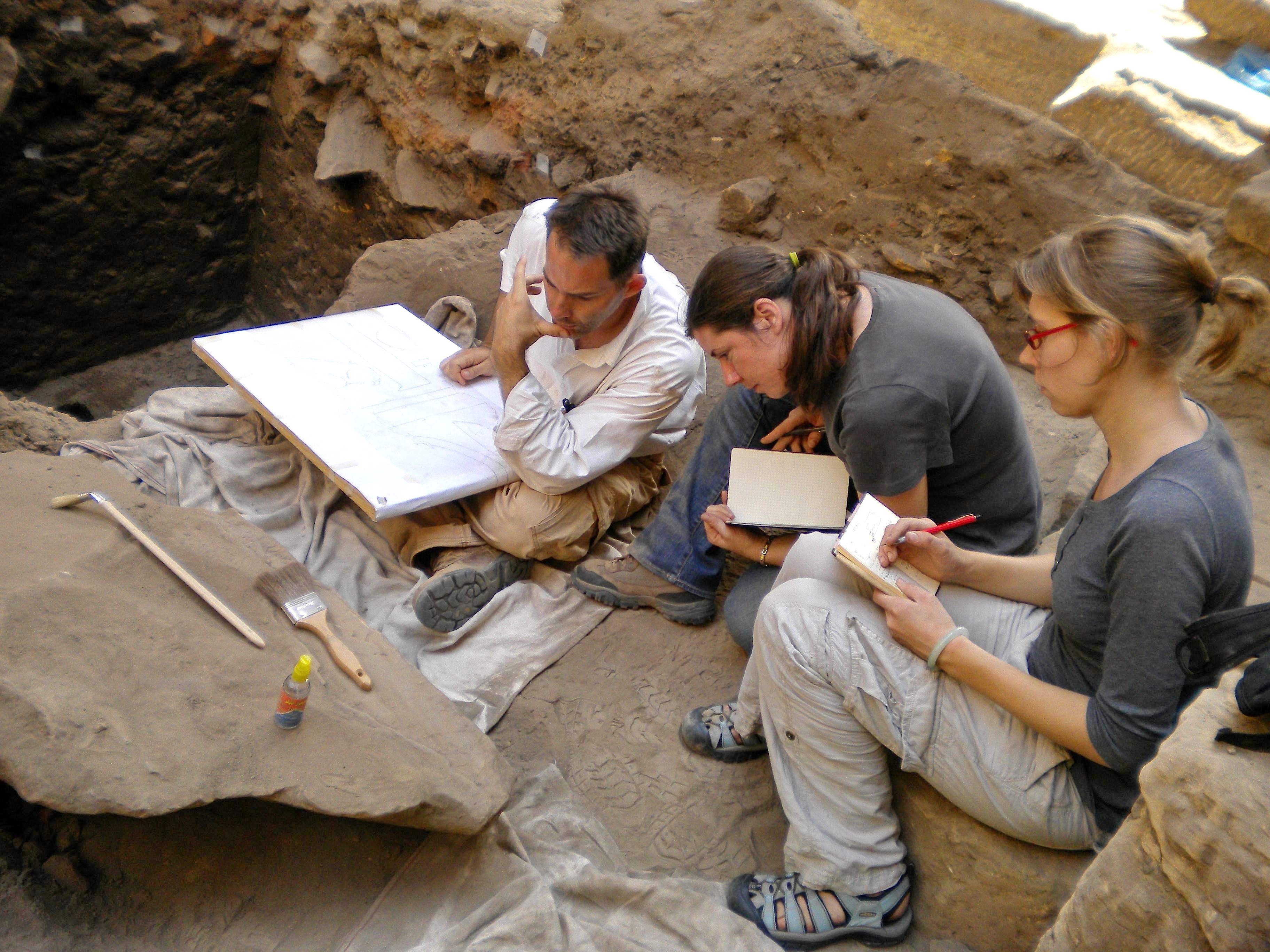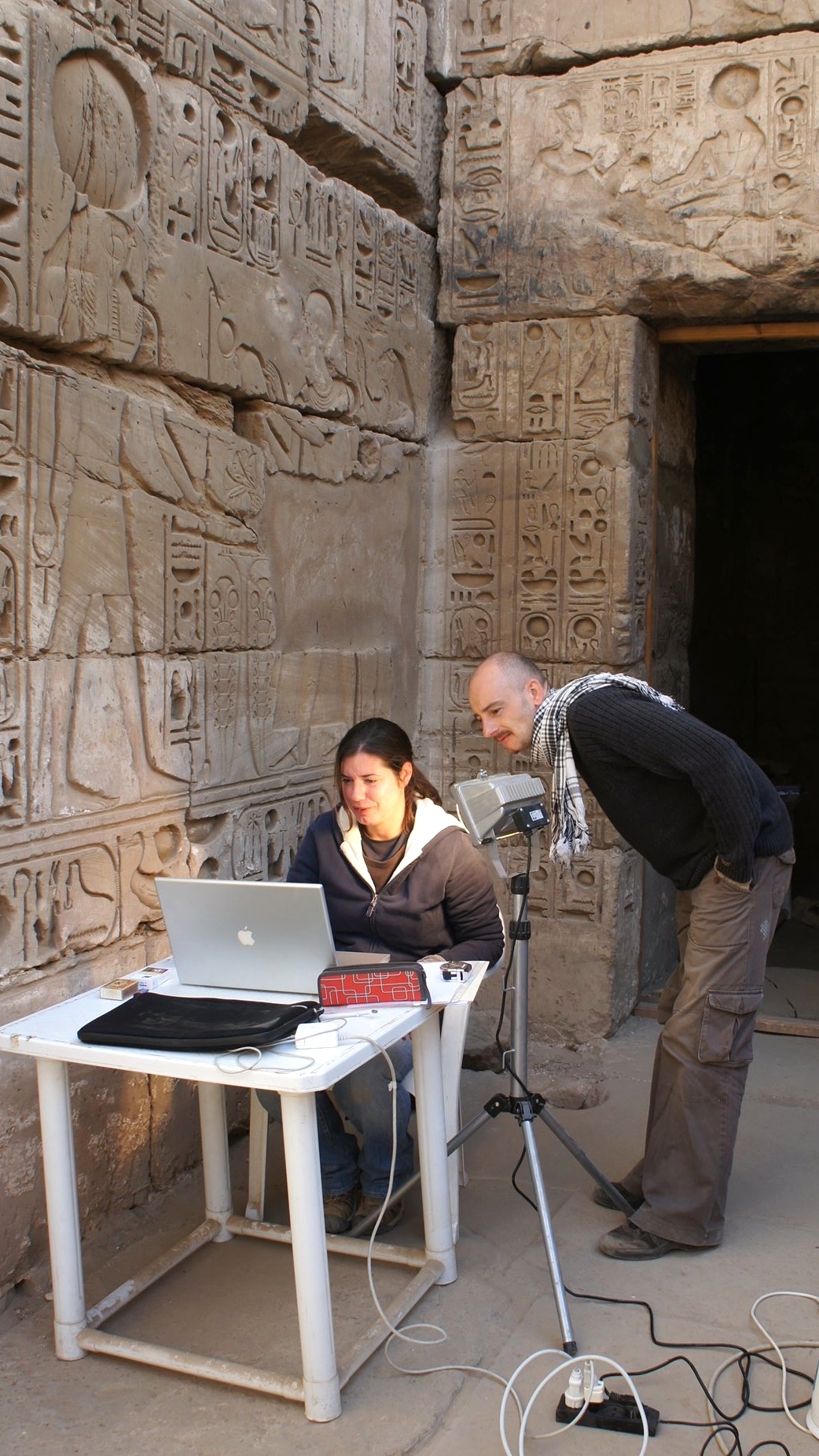- EraNew Kingdom
- Project DirectorDr. W. Raymond Johnson
- LocationLuxor
- AffiliationOriental Institute of the University of Chicago
- Project SponsorAntiquities Endowment Fund
- Project Dates2008-2013
Written by: Courtney McRae Crawford
Since the 1930s, the Epigraphic Survey of the Oriental Institute, University of Chicago, based at Chicago House in Luxor, has been undertaking field research at Khonsu Temple within the Karnak temple precinct. In 2008, in cooperation with the American Research Center in Egypt (ARCE) and under the supervision of the Supreme Council of Antiquities (SCA) and the Ministry of State for Antiquities Affairs (now the Ministry of Tourism and Antiquities), the Chicago House team led five successful field seasons (2008-2013) to document inscribed blocks from the 18th and 19th Dynasties that had been reused as building material in the construction of the 20th Dynasty temple. This work took place in parallel with ARCE’s project to restore portions of the temple, with funding from the U.S. Agency for International Development (USAID). During the 20th Dynasty, Ramses III rebuilt the temple to Khonsu, the divine child of Amun and Mut, in the southwest corner of the Karnak Temple enclosure. Amun, Mut, and Khonsu constituted the Theban Triad, the ruling gods of this region. While it has long been known that Ramses III erected this temple for Khonsu, the Epigraphic Survey’s fieldwork has provided much additional information concerning the lengthy and complex history of this monument.
Team members Brett, Jen and Keli recording blocks in foundations of the Khonsu temple court, 2009. Photo: Ray Johnson.
Khonsu Temple provides an abundant amount of epigraphical information about many different rulers in the New Kingdom. The names of kings inscribed on the blocks include Thutmose III, Amenhotep II, Amenhotep III, Thutmose IV, Ay, Horemheb, Seti I, Ramses II, and Seti II. Furthermore, a plethora of older limestone blocks from a Middle Kingdom temple were also found.
Team member Krisztian recording block in trench, 2008. Photo: Pam Rose.
In order to document the blocks of Khonsu Temple, the Chicago House team had to work diligently to record the exposed texts before the restoration could begin. Sometimes, a block could be easily recorded when surrounding stones were missing. However, many of the blocks had to be recorded while observing them through tiny gaps between the stones. The team created their own “salvage epigraphy” system during their work at the temple. Traces of the stones would be recorded on diacetate plastic or redrawn from aluminum foil that was pushed between the stones and traced over. Although the process was timing consuming and difficult, the team was able to properly document the epigraphic material.
During the five field seasons, Chicago House successfully recorded a total of 765 blocks. During the floor restoration process, epigraphic texts from older temples were discovered and thoroughly recorded. Repaving of the floors was planned as part of the temple’s overall restoration, and so the reused blocks had to be properly recorded beforehand. The Epigraphic Survey’s work is essential because once the floor is repaved, the reused blocks will no longer be available for research.
Chicago House’s research illustrates that the blocks from the floor and foundation originally come from the mortuary temples of Amenhotep III, Ay, and Horemheb. Additionally, evidence from the rear sanctuary suggests that the blocks there were originally from a smaller temple during Thutmosis III’s reign and the court floor came from the reign of Seti I. Khonsu Temple holds copious amounts of information not only in relation to the reign of Ramses III but also to previous New Kingdom rulers.
Artist Krisztian Vertes and the Chicago House team were successfully able to record the blocks by tracing, scanning, and drawing the epigraphic material. The team modified the damage to the material but with minimal alterations to preserve the original content. The offering scenes display the god Khonsu. Also, the Thutmoside blocks and one for Horemheb contain recarving from the reign of Ramses II. This evidence suggests that the practice of appropriating previous temples in Pharaonic times was common. Thorough epigraphic surveying techniques provide information about Khonsu Temple and other monuments that have been previously dismantled.
Team member Jen and artist Krisztian working on the Khonsu block database, 2010. Photo: Ray Johnson.
The Chicago House team’s research provides more context to the construction of the 20th Dynasty temple and a better understanding of monuments from previous rulers. A large number of blocks from Seti I’s reign suggest a possible monument that was unknown before, while the barque shrine appears to have been made from numerous areas in Karnak. The Khonsu Temple project has received permission to continue, where future work will provide not only more context to the temple but also to other monuments that once existed in Karnak.
For a detailed lecture given by Epigraphic Survey director Ray Johnson on July 24th, 2021 about the work of Chicago House at Khonsu Temple, click here


